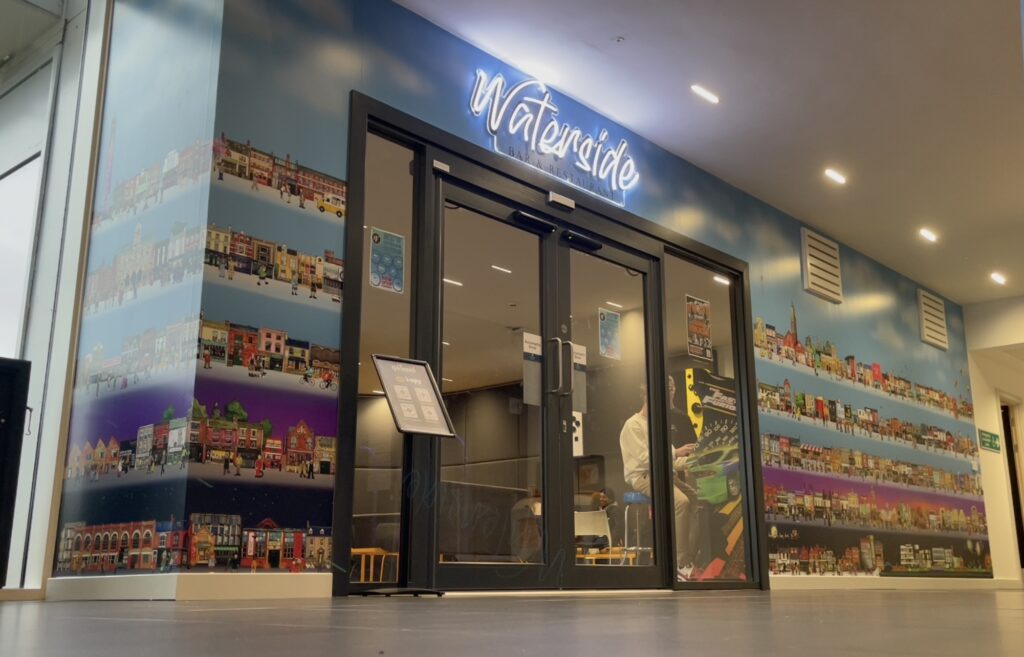
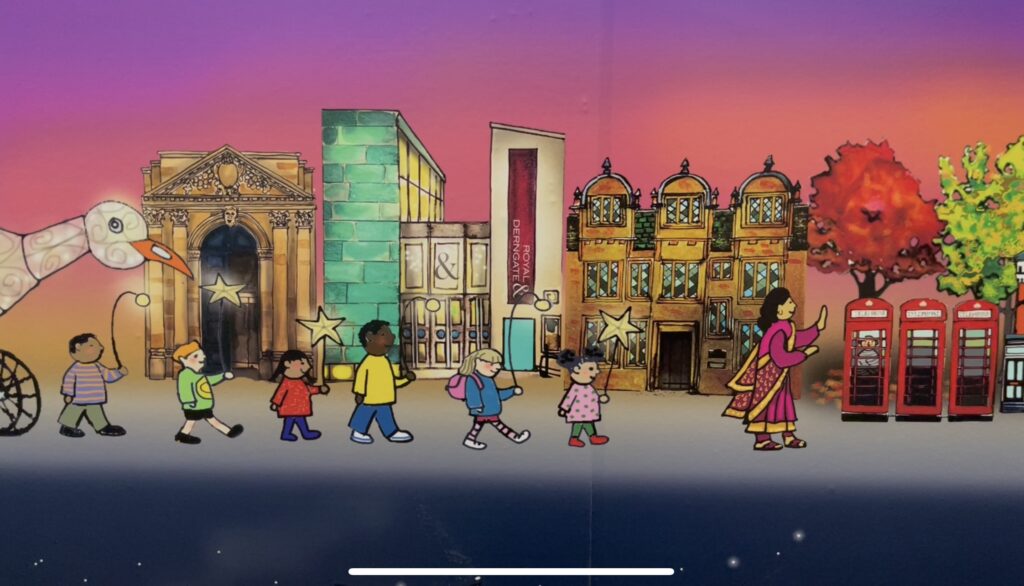
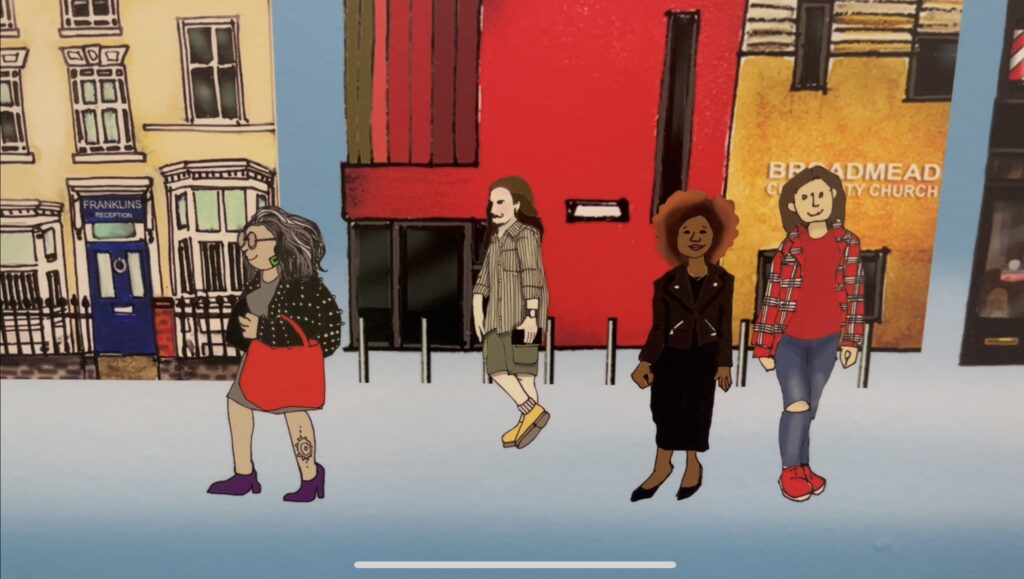

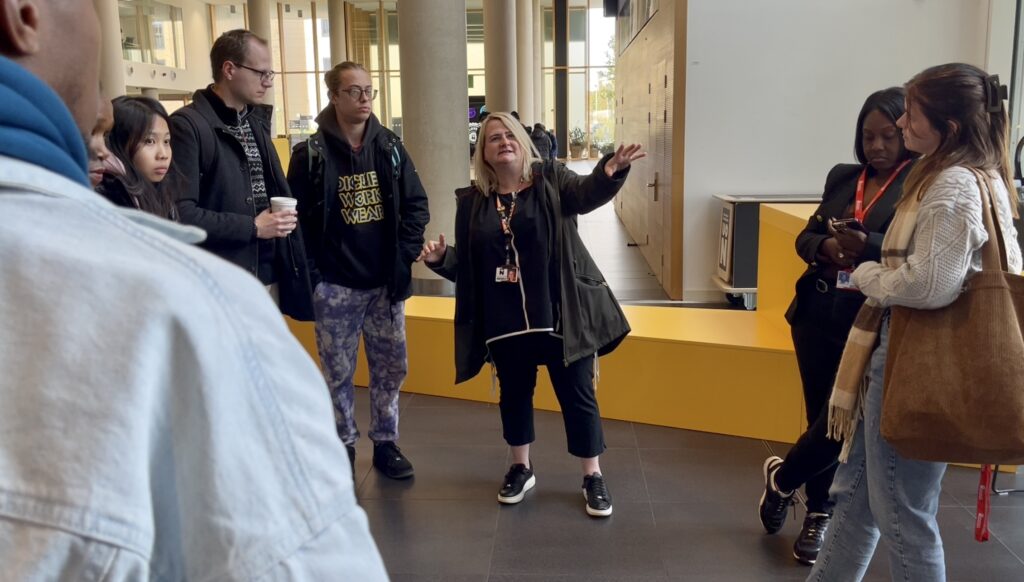
In the heart of the Waterside Campus, a new art installation by Senior Digital Marketing Lecturer and creative artist Kardi Somerfield is rewriting the rules of engagement, merging art and education to create a unique learning experience and visual identity for the newly refurbished Waterside bar. We recently had the opportunity to meet with Kardi Somerfield, to discuss her work.
Kardi’s work stands as an extraordinary tribute to Northampton, stretching three meters in height and an impressive nine meters in length. It encapsulates the very essence of Northampton. Boasting over 200 distinct locations and nearly 300 characters, this monumental piece symbolizes the heart and soul of the town. The installation, at its core, epitomizes inclusivity in our local community.
Creating a work of these dimensions came with its own set of challenges. Transitioning from drawing on a digital screen to delivering a huge-format vinyl involved creating a vast Photoshop file with over 1000 layered elements including buildings, characters, and wildlife.
One of the most intriguing aspects of Kardi’s creation is its interactive dimension. By integrating QR codes, she created a digital-physical bridge, allowing visitors to interact with the artwork in unique ways. This innovative artwork blends digital and analog technologies and transcends the visual spectacle to become a powerful pedagogical tool, particularly for storytelling within the realm of education.
Click here to watch the interview on Kaltura Player.
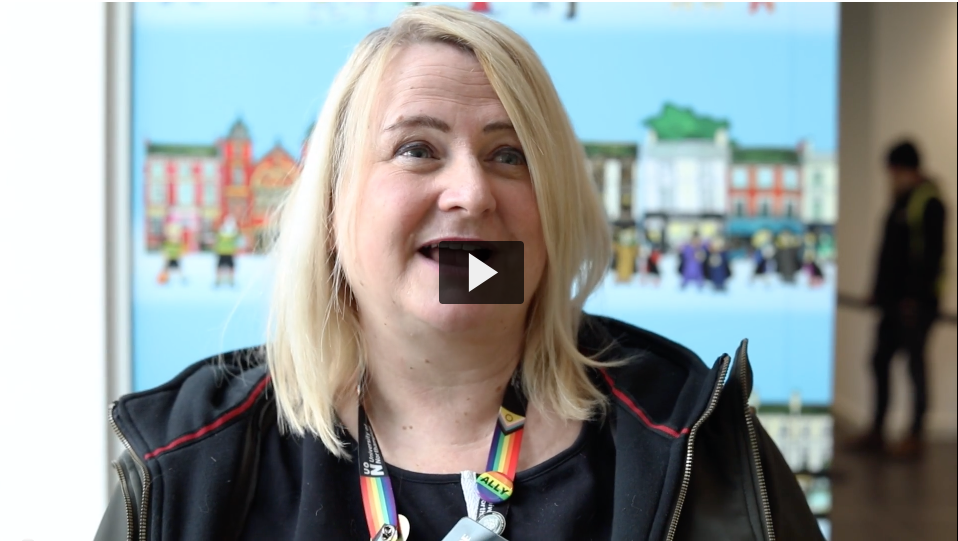
Learning Technologists Richard Byles and Kelly Lea, and Head of Learning Technology Rob Howe have published the outcomes of their research into student perspectives of Artificial Intelligence on the LTE (Learning Teaching Excellence) platform.
The insights presented in the report are derived from their student survey launched in May 2023, focusing on a range of topics including reasons and barriers for adopting AI tools, ethical considerations and thoughts on staff use to create new content.
The report provides a clear and concise presentation of their research results, discoveries, and conclusions with input from Kate Coulson, Head of Learning and Teaching Enhancement and Senior Lecturer in Fashion Jane Mills. The central theme here revolves around the crucial dialogue surrounding the inclusion of student opinions in shaping AI guidance within the educational landscape.
Currently, Richard and Kelly are on the lookout for volunteers who can participate in video interviews on uses of AI in the classroom. These aim to shed light on how educators are introducing Generative AI Technologies to students, further enriching our understanding of AI’s role in education. Your voice could be an essential part of this ongoing research.
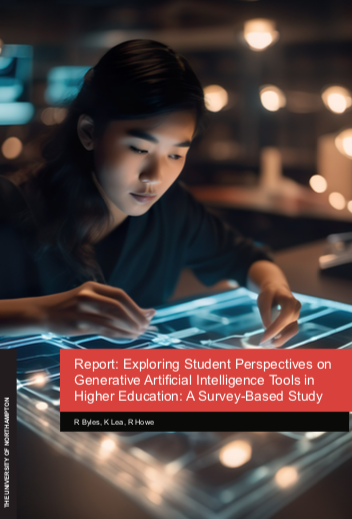
Report Link (PDF): Exploring Student Perspectives on
Generative Artificial Intelligence Tools in
Higher Education: A Survey-Based Study
R Byles, K Lea, R Howe
More Information
More information about the University’s position on AI is available from:
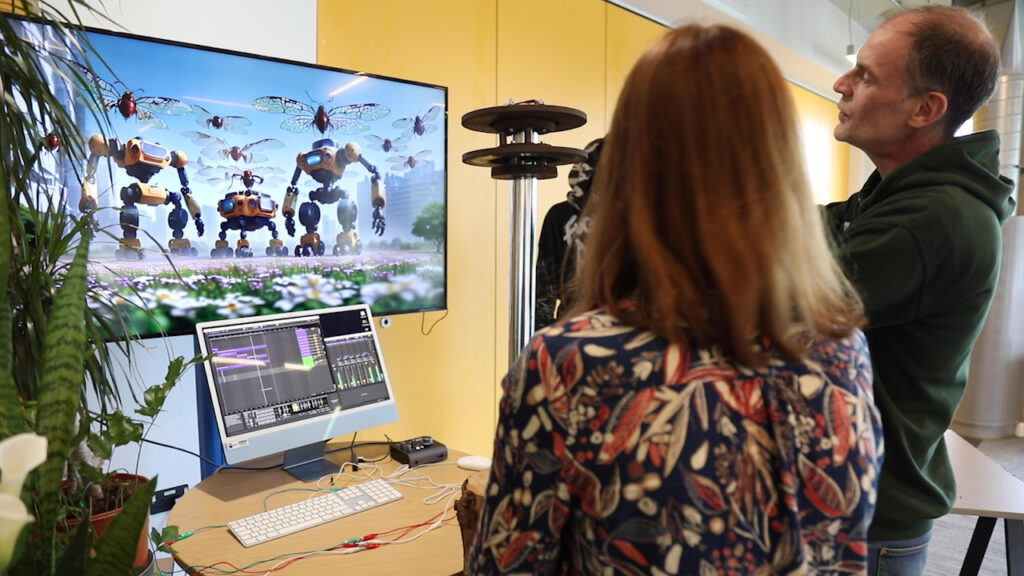
In this short video Learning Technologist Belinda Green speaks to Mark Thursby, a Senior Lecturer in Music, and two of his music students about their experimental sound installation “Of Sound Mind” presented at the University of Northampton on May 16th and 17th, 2023.
Mark explains how anything conductive can be converted into MIDI notes and music, allowing humans to interact with the installations by touching conductive elements such as leaves. The result was an AI insect hybrid garden that generated unique sounds and created an immersive experience. The installations also had the ability to daisy chain people, where participants could hold hands and the last person could touch a leaf to activate the system.
Belinda speaks to music students Ben Wyatt and Kai Downer who discuss the effectiveness of background sounds, such as a café or a public space to create an immersive surround sound atmosphere and how conductivity and human interaction can be used to create immersive sounds that are ‘in key’ using new technologies.
The interview highlights the captivating and interactive nature of the “Of Sound Mind” installations. The fusion of music, AI technology, and interaction created an immersive experience for participants. The enthusiasm expressed by the interviewees showcased the exciting possibilities that lie ahead, particularly for students and the advancement of music technology.
Case study produced by Richard Byles and Belinda Green.
The use of 3D printing and scanning in the prosthetics and special effects industry is an emerging field with immense potential. In this video case study, technician demonstrator Paddy Costelloe from Games & Computing Software Technology discusses how he took Hair and Makeup students through the entire process of 3D scanning and printing to create prosthetics, from scanning to repairing the scanned data and using Cura software to create 3D prints.
The students discuss how they were able to see the process firsthand, with one of them getting a scan of their face. The goal was to excite the students about the prospects of 3D printing and how it can be used to improve the industry. Students’ comments in the film include; that it was great to see the technology in action after reading about it in theory and that they found the breakdown of the technology easy to understand and could see how they would use it in their future work.
Poppy Twigger, Technician Demonstrator for Hair, Makeup and Prosthetics, highlights the potential of 3D printing in the industry, with 3D printed molds, makeups, and props becoming increasingly common. She emphasizes that while 3D printing would not replace practical effects, it is quickly becoming an integral part of the industry, allowing for a blended procedure that increases the quality and speed of the makeup process. The use of 3D printing in prosthetics and special effects is an exciting development that is set to transform the industry in the coming years.
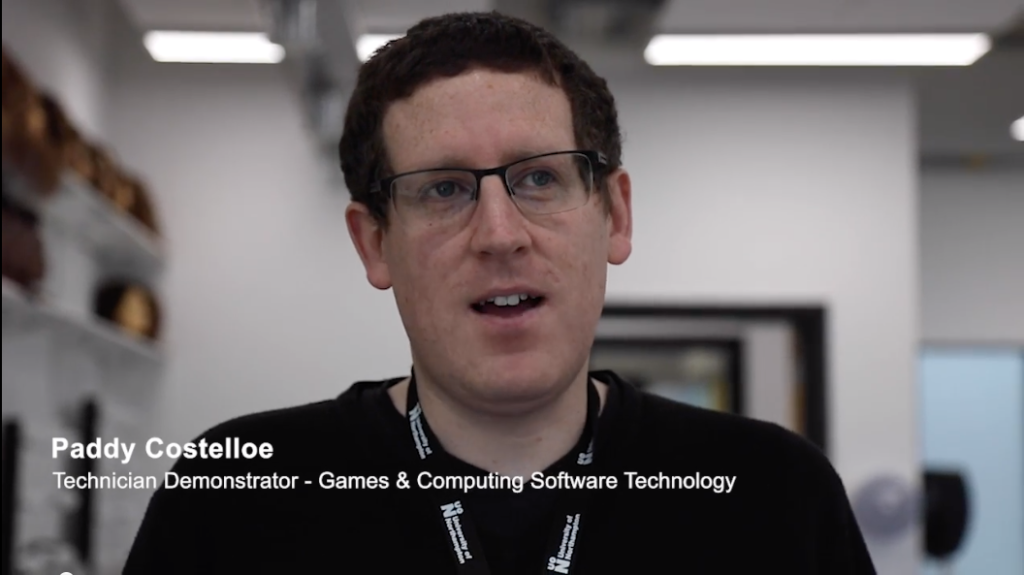
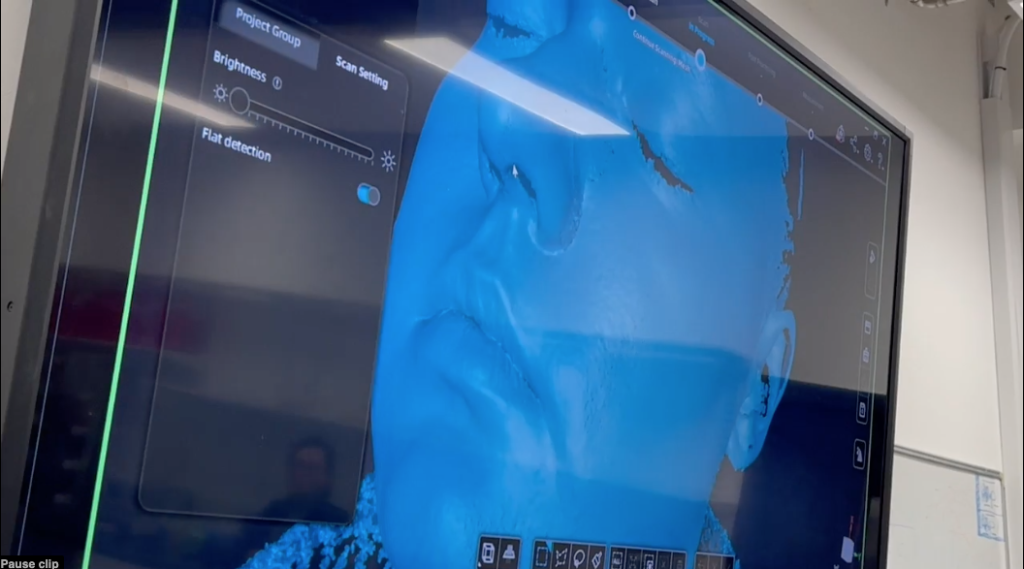
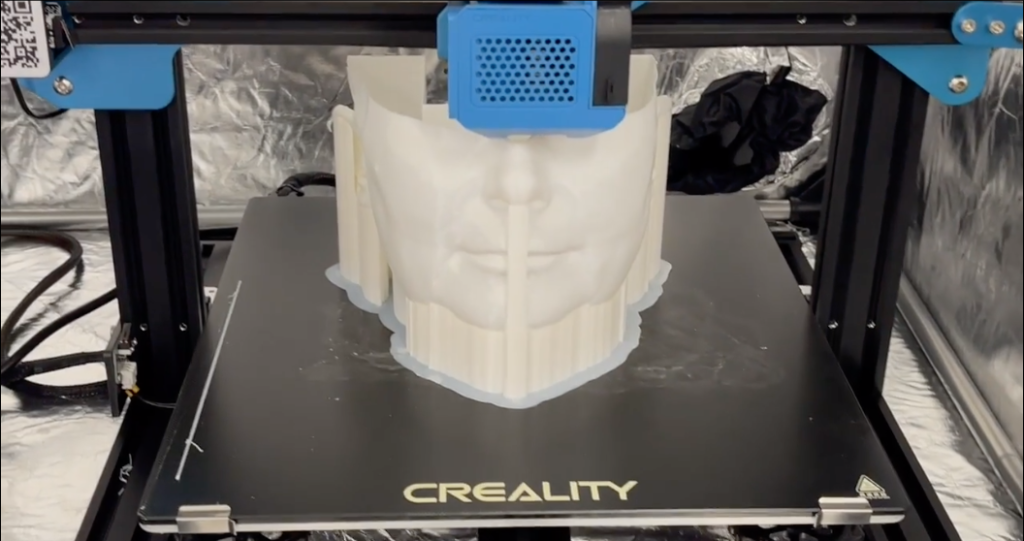

Virtual reality (VR) and augmented reality (AR) are quickly gaining traction at the University as effective technologies for teaching and learning.
With VR in particular, it is tempting to imagine a world in which students fit their headsets for a complete University experience. However, as these four films show the reality is more interesting at UON with academics exploring how these technologies can be used in a wide range of creative ways in the classroom.
The first film explores how in 2022-23 Senior Lecturer in Marketing Kardi Somerfield worked with the Police Fire and Commissioners office on a live VR brief to create a virtual reality scenario to promote safer student experiences in Northampton.
(Click the images or text links below to launch the videos in a new tab)
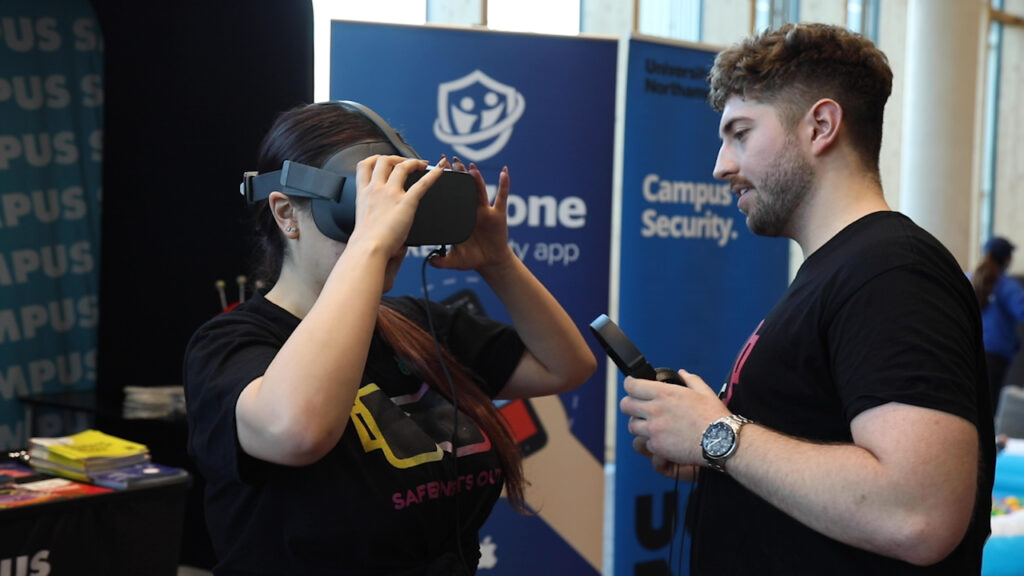
Video: Interview with Kardi Somerfield – Safer Northampton VR Project Duration: 3.55
Using a RiVR Link system the Second-year Digital Marketing students conceptualised, planned, recorded, edited, and released their unique VR experience with accompanying branding including flyers, T-shirts, and signage.
The project was launched to widespread acclaim and media attention, providing the students with highly valuable digital skills. It is an exemplar of how VR technologies can be used creatively as content creation tools in subject areas that are non-technical.
The second film looks at how the subject area of Health is using VR and XR technologies. Sims Lead Kate Ewing and Nursing Senior Lecturer Hannah Cannon discuss how VR software is helping to develop nursing students’ critical skills through the use of interactive hospital scenarios. The simulation tools are used in combination with debriefing discussions that provide rich learning experiences matching the tutor’s individual learning outcomes.
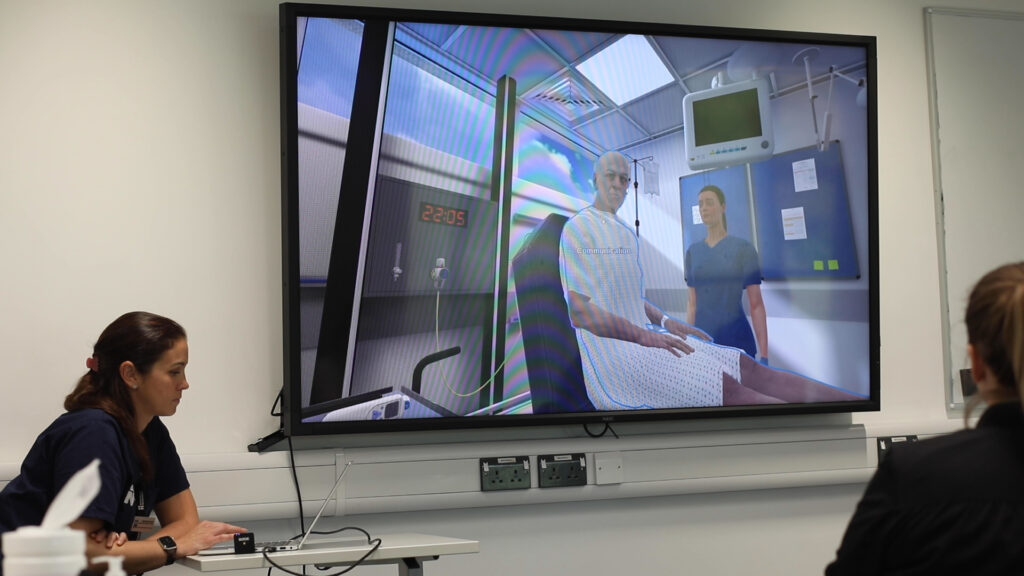
Video: Interview with Kate Ewing and Hannah Cannon on Developing Health Simulations. Duration: 7.41
Our next video case study focuses on how Senior Lecturer in Games Design David Nicholls works with his students to create prototype VR games. He discusses how VR and XR are areas that are both very popular with students and have huge potential for their future employability. So much so, that he is currently collaborating on the development of VR projects across multiple subject areas within the University.
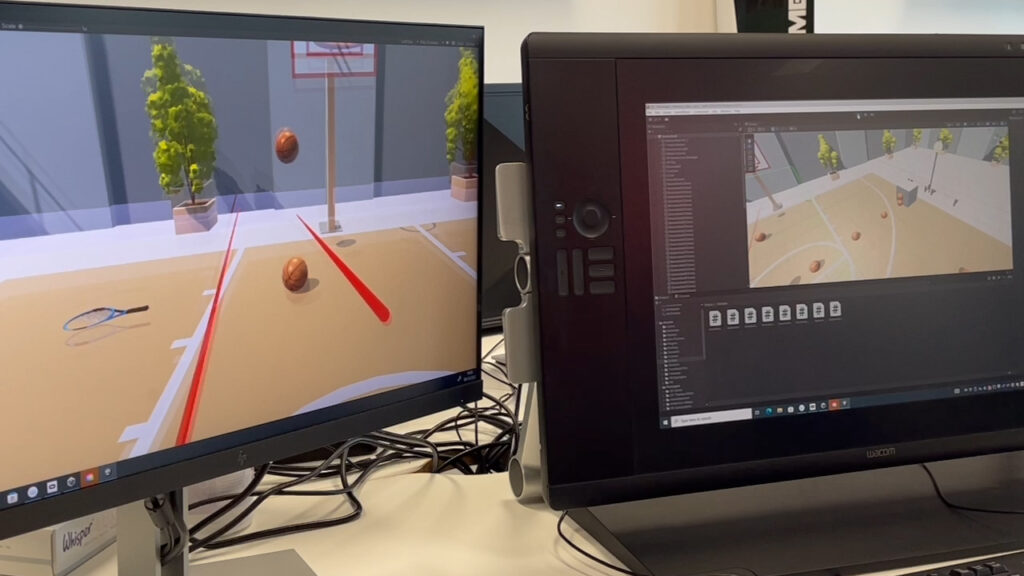
Video: Interview with David Nicholls on use of VR in Games Design. Duration: 2.17
And finally, the last film in this series looks at how the University’s CENTRE FOR ACTIVE DIGITAL EDUCATION (CADE) has launched a number of Special Interests Groups (SIGs) for new technologies such as XR (including MR, VR and AR), Artificial Intelligence (AI), Distance Learning (DL) and Game-Based Learning (GBL).
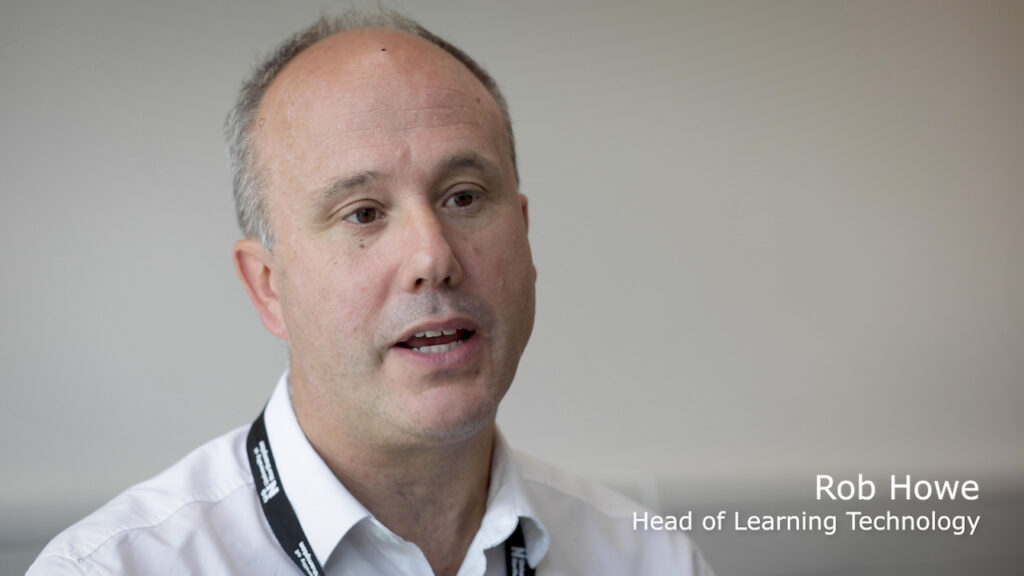
Video: Interview with Rob Howe on CADE and VR special interest groups. Duration 2.42
Head of Learning Technology Rob Howe explains that CADE is a platform for creative discussion on the teaching and learning opportunities afforded by these extended reality technologies, and how by taking a strategic approach to the development of XR and working collaboratively more students and staff will benefit from our expanding expertise in this area.
For more details on the CENTRE FOR ACTIVE DIGITAL EDUCATION (CADE) and to join the discussions please see: https://www.northampton.ac.uk/research/research-institutes-and-centres/centre-for-active-digital-education-cade/
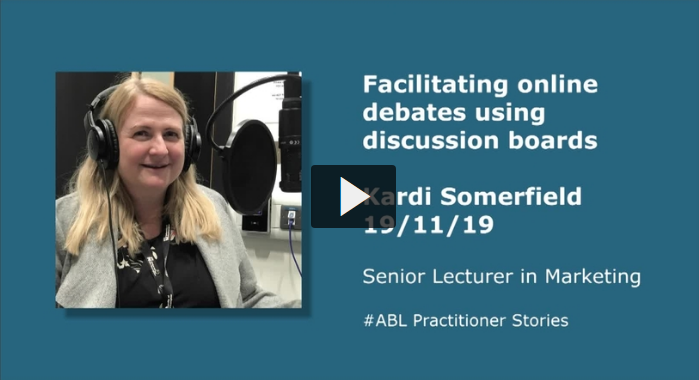
Senior Lecturer in Marketing Kardi Somerfield provides a reflective insight into how students can be involved in both module content creation and assessment design, by facilitating online debates which inform the end of year exam.
Working with third year Marketing students in the module ‘Issues of Advertising Practice’, Kardi encourages her students to view the debates as an opportunity for democratic learning by giving them the role of a weekly chair. To fulfil this role students must begin a topic with their own question, host a debate and nominate a best post of the week.
Her approach has been highly commended by the module’s External Examiners as being innovative and well run. The Dean of Learning and Teaching, Prof Ale Armellini said: “Kardi’s approach is highly engaging for students, as well as rigorous and innovative. This is an exemplar of active blended learning in practice, where student centredness, personalisation and interaction operate together towards the achievement of outcomes and a fantastic learning experience”.
In this short video Academic Librarian Joanne Farmer explains how academics can best use Aspire reading lists to engage their students.
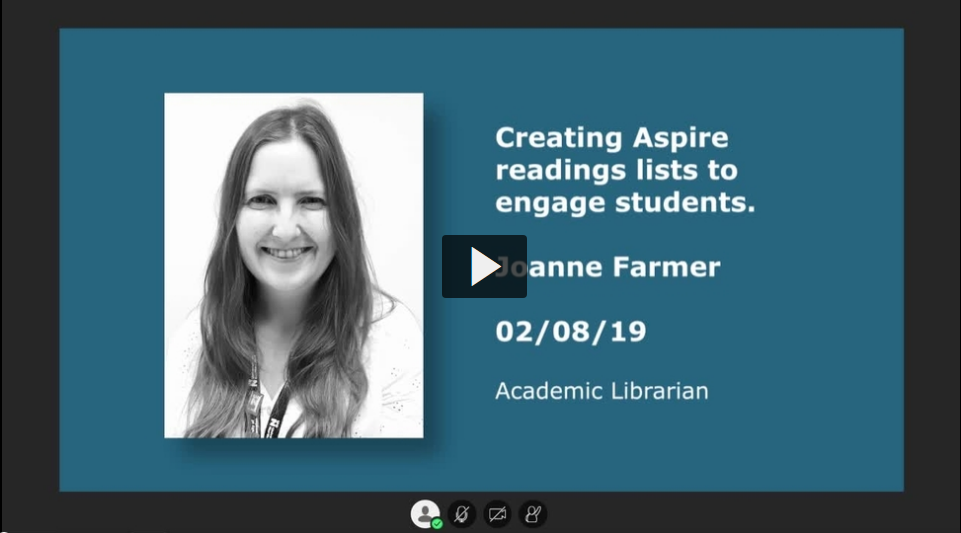
Aspire Readings lists are created and maintained by module tutors. They are added to each module site and can contain links to books, e-books, journals and audiovisual resources.
Joanne says “reading lists are an important part of the student learning journey and often a starting point for any research or work undertaken. It is worth spending time developing reading lists so students are encouraged to engage with a range of resources”. She cites Rob Farmer’s reading list –
An Introduction to Climate Change for Non-Scientists and Non-Specialists, as a good example to look at for ideas as it has an engaging narrative and structure.
The creation and updating of reading lists are supported by the Academic Librarians who can be contacted by email: librarians@northampton.ac.uk
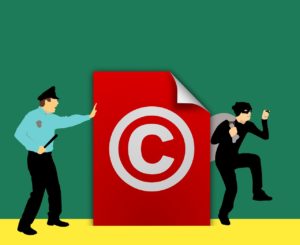
Image – Pixabay, no attribution required.
I was recently asked about the Copyright exception ‘Fair Dealing’ and what this means when uploading media content such as videos, podcasts and images within a VLE such as NILE.
As an experienced web designer my understanding of copyright is based on knowledge of online publishing rather than use in Education and therefore I was interested in finding out exactly what this means, and how it applies to our VLE – NILE.
But, before I begin looking at this, I’d like to signpost you to Iain Griffin’s comprehensive post ‘Copyright and online publishing‘. (1) which explains the functions of copyright and contains links to a wide range of online resources which are freely available and can be legally included in any teaching materials without infringing copyright.
What does the term ‘Fair Dealing’ mean?
The UK government’s guidance ‘Exceptions to copyright: an overview‘ (2) include a number of possible exceptions to copyright which come under the term ‘Fair dealing’:
- Caricature, Parody or Pastiche
- Quotation
- Research and Private Study
- Text and Data-Mining
- Archiving and Preservation
- Public Administration
- Accessible formats for disabled people
(Information on each of these is covered in the guide above).
The guide also states that ‘Fair Dealing’ is only applicable when no other licence is in place. so existing licences such as the CLA (Copyright Licensing Agency) (3) for books and journals, ERA (Educational Recording Agency) (4) for off-air broadcast recordings, and other licences such as those with third-party educational providers all take precedence.
From the government document Exceptions to copyright: Education and Teaching (5) I have pulled out a few key points that I think help in our understanding of how this law applies to a VLE.
- Understanding the term ‘Fair Dealing’
‘Fair dealing’ is a legal term used to establish whether a use of copyright material is lawful or whether it infringes copyright. There is no statutory definition of fair dealing – it will always be a matter of fact, degree and impression in each case. The question to be asked is: how would a fairminded and honest person have dealt with the work? - Fair dealing includes the use of multimedia content.
Fair Dealing… ‘permits minor acts of copying for teaching purposes, as long as the use is considered fair and reasonable. So, teachers will be able to do things like displaying webpages or quotes on interactive whiteboards, without having to seek additional permissions.’ - ‘Fair dealing’ is not a way of avoiding licensing.
The majority of uses of copyright materials continue to require permission from copyright owners, so you should be careful when considering whether you can rely on an exception, and if in doubt you should seek legal advice. - Is Fair dealing internationally recognised?
No. Copyright is a territorial right, and different acts are permitted in different countries. You need to ensure that you comply with the laws of the countries in which you provide online resources.
Relevant sections from The Copyright, Designs and Patents Act 1988.
The ‘Illustration for instruction’ exclusion is referred to in a post on copyrightuser.org (6) by Ruth Soetendorp and Bartolomeo Meletti.
This is from Section 32 of the ‘Copyright, Designs and Patents Act 1988‘ (7), and includes three stipulations:
- The use of materials must be ‘minor and fair’.
- The inclusion of materials must not undermine sales.
- Appropriate acknowledgement of authorship must (where possible) be given.
JISC’s guidance on ‘Fair Dealing‘ (8) (Joint Information Systems Committee) states that ‘Under Section 32 CDPA – ‘Illustration for instruction’, it is valid for a lecturer to use extracts from ‘films, sound recordings and broadcasts as well as text, music and artistic works to illustrate a teaching point.’ However, is unclear on whether this applies within a classroom or in a VLE.
The reason for the lack of clarity is because in the original legislation The Copyright, Designs and Patents Act 1988 and the updated The Copyright and Rights in Performances (Research, Education, Libraries and Archives) Regulations 2014 (9) neither is specific to where this exception ‘illustration for instructions’ applies.
Confusingly, in the more recent legislation (2014) there is specific mention of use in a ‘secure electronic network accessible only by the establishment’s pupils and staff’, but only in Sections 35 and 36.
Section 35 covers the use of ‘broadcast’ materials – which are most likely already covered by University’s ERA license, and Section 36 ‘Copying and use of extracts of works by educational establishments’ stipulates that this does not include ‘artistic work’ or ‘broadcast’ materials, and therefore is more likely to be most relevant to materials such as books and journals which are also already covered by the CLA.
As mentioned previously the ‘Fair Dealing’ exceptions only come into play when existing licences do not exist, so this may explain why these exclusions not included in JISC or copyrightuser.org’s guidance and the older ‘illustration for instruction’ is more widely cited.
Examples of how other Universities interpret copyright exceptions.
The points above are interesting because available ‘Fair dealing’ guidance published online by other UK Universities’ most commonly mention the exception Section 32 ”illustration for instruction’. However, the guidance is not consistant across the sector.
The University of Cambridge web page; ‘Copyright and VLE’ (10), proposes that (their) academics are permitted to use short extracts from ‘literary and musical works, films, sound recordings and broadcasts as well as artistic works to illustrate or reinforce a teaching point in lectures and in restricted intranets such as Moodle, provided the original source is explicitly acknowledged’, on the condition that access is ‘limited to those receiving the instruction, preferably to those enrolled on a particular course of study’, and materials are not made available on outward facing web sites such as faculty, departmental or social media.
Staffordshire University’s’ Copyright Guidance (11) takes a similar approach and suggest that it is permissible to take clips off a DVD and upload to a VLE for the purposes of ‘ illustration for instruction’, if the three stipulations in Section 32 are met. They also consider the restriction of learner access to the VLE – a secure network, as a factor in whether the use is considered ‘fair’, and extend their guidance the use of images and lecture capture where copyright materials are used to ‘illustrate a teaching point’.
Guidance on embedded media in Brunel University Library’s post ‘Can I use YouTube content for teaching in Blackboard Learn?’ (12) suggests that embedding a YouTube clip in a VLE is more complex than viewing it as an individual, as sharing a YouTube clip with multiple users ‘may be in breach of UK copyright law as a secondary infringement’. As a result, they go beyond YouTube’s recommendation (13) that the educator should request permission from the uploader, and suggest they should also check that ‘the person granting permission is authorised to do so’.
Fair Dealing at the University of Northampton.
Head of Academic Services (Library and Learning Services), Georgina Dimmock, has provided guidance on copyright exceptions and fair dealing, which can be found on the LLS Copyright (14) web pages. Due to the complexity of the law, and how the fair dealing exceptions can be used with Higher Education, SCONUL (Standing Council on University and National Libraries) is looking to commission a copyright expert to advise on how libraries can use exceptions to support teaching and learning in institutions. (15)
Georgina notes that when using a Fair Dealing exception, it is the responsibility of an academic to make a decision on whether it is ‘Fair dealing’, and individual academics must consider the risks of material uploaded to a VLE.
What action may be taken?
JISC’s guidance Enforcement of copyright, (16) advises that the copyright holder must take legal action against the person they believe has infringed their rights, and by applying to the course the individual can;
- Stop a person making further infringing use of the material by seeking an injunction, interdict or other order.
- Claim damages from those who infringe their copyright.
- Require the infringing party to give up or destroy the infringing.
As the UK Law is based on the principle of ‘Common Law‘ (17) any successful cases will set a precedent for future prosecutions, a point that is driven home on a post on the Conversation.com (18) web site details how a Canadian University has been successfully prosecuted under copyright law and, ‘must pay millions of dollars in licensing fees..’ as a result of a ‘more restrictive interpretation of fair dealing when it comes to educational materials’.
While this international case does not affect UK case law, it does highlight that should a copyright prosecution successfully argue that ‘illustration to instruction’ does not apply to online distribution in a VLE, UK Universities may be required to take a harder line with staff’s use of copyrighted materials in the future.
Copyright risks and alternatives.
As any use of copyright materials contains an element of risk, it would be advisable for staff to consider whether there are licensed alternatives available such as BoB (Box of Broadcasts) (19) which contains over 2 million recordings covered by our ERG licence, or to filter the search in platforms such as YouTube for materials that licensed under a Creative Commons license. (20) and are attributable to a reliable source such as TedTalks (21) or YouTube Education (22) where the copyright holder can be reliably identified.
Where media is only available without a creative commons license, an academic will need to make a decision on whether ‘Fair dealing’ applies, if they believe so, they should be knowledgable of restrictions of the exclusion ‘Illustration for instruction’ and ensure that any media used is; minor and fair, does not affect the potential sales of the copyright holder, and that attribution is given correctly.
When considering this I suggest it’s advisable to imagine yourself before a judge: do you think you could argue successfully that your use of materials under illustration for instruction fits into all of these criteria?
Post Contributors:
Richard Byles – Learning Technologist.
Georgina Dimmock – Head of Academic Services (Library and Learning Services)
References:
(1). Griffin, I., 2015. Copyright and online publishing. The University of Northampton. [ONLINE] Available at: http://blogs.northampton.ac.uk/learntech/2015/06/05/copyright-online-publishing/. [Accessed 6 March 2019].
(2). Intellectual Property Office Online. 2014. Exceptions to copyright: An Overview. [ONLINE] Available at: https://assets.publishing.service.gov.uk/government/uploads/system/uploads/attachment_data/file/448269/Exceptions_to_copyright_-_An_Overview.pdf. [Accessed 6 March 2019].
(3) CLA (Copyright Licensing Agency Limited). 2019. [ONLINE] Available at: https://www.cla.co.uk/higher-education-licence
(4) ERA (Educational Recording Agency) 2019. [ONLINE] Available at: https://era.org.uk/the-licence/
(5) Intellectual Property Office Online. 2014. Exceptions to copyright: Education and Teaching. [ONLINE] Available at: https://assets.publishing.service.gov.uk/government/uploads/system/uploads/attachment_data/file/375951/Education_and_Teaching.pdf. [Accessed 6 March 2019].
(6) Soetendorp, R and Meletti, B. Unknown. Education. Copyrightuser Organisation[ONLINE] Available at: https://assets.publishing.service.gov.uk/government/uploads/system/uploads/attachment_data/file/375951/Education_and_Teaching.pdf. [Accessed 6 March 2019].
(7) UK Gov. 2014. Copyright, Designs and Patents Act 1988. [ONLINE] Available at: http://www.legislation.gov.uk/ukpga/1988/48/part/I/chapter/III/crossheading/education. [Accessed 6 March 2019].
(8) JISC. 2014. Exceptions to infringement of copyright. [ONLINE] Available at: https://www.jisc.ac.uk/guides/copyright-law/exceptions-to-infringement-of-copyright. [Accessed 6 March 2019]
(9) UK Gov. 2014. The Copyright and Rights in Performances (Research, Education, Libraries and Archives) Regulations 2014 [ONLINE] Available at: http://www.legislation.gov.uk/uksi/2014/1372/regulation/4/made [Accessed 11 July 2019]
(10) University of Cambridge. 2019. Scholarly Communication: Copyright and VLE. [ONLINE] Available at: https://osc.cam.ac.uk/copyright/copyright-and-vle. [Accessed 6 March 2019]
(11) Howlett, S. 2017. Copyright Guidance Staffordshire University. Staffordshire University Library.[ONLINE] Available at: https://libguides.staffs.ac.uk/c.php?g=143453&p=937822. [Accessed 6 March 2019].
(12) Ritchie, M. 2014. Q. Can I use YouTube content for teaching in Blackboard Learn? [ONLINE] Available at: https://libanswers.brunel.ac.uk/faq/13827 [Accessed 6 March 2019].
(13) Google/YouTube Support. Unknown. Educator resources. [ONLINE] Available at: https://support.google.com/youtube/answer/2802327?hl=en. [Accessed 6 March 2019].
(14) UoN Library and Learning Services. 2019. [ONLINE] LLS Copyright: Copyright and licensing in Higher Education: Copyright exceptions and fair dealing. Available at: http://libguides.northampton.ac.uk/copyright/copyright_exceptions [Accessed 11 July 2019]
(15) SCONUL. 2019. Call to action: developing a copyright briefing – Wed, 23 Jan 2019. [ONLINE] Available at: https://www.sconul.ac.uk/news/call-to-action-developing-a-copyright-briefing. [Accessed 6 March 2019].
(16) JISC. 2017. Copyright law. [ONLINE] Available at: https://www.jisc.ac.uk/guides/copyright-law. [Accessed 6 March 2019].
(17) Bodleian Libraries University of Oxford. 2018. United Kingdom Law: Case law. [ONLINE] Available at: http://ox.libguides.com/c.php?g=422832&p=2887381. [Accessed 6 March 2019].
(18) Bannerman, S., 2017. Why universities can’t be expected to police copyright infringement. The Conversation Trust (UK) [online]. Available from: https://theconversation.com/why-universities-cant-be-expected-to-police-copyright-infringement-82677. [Accessed 6 March 2019].
(19) Learning on Screen – the British Universities and Colleges Film and Video Council. Box of Broadcasts. 2019. [ONLINE] Available at: https://learningonscreen.ac.uk/ondemand
(20) National Copyright Unit Australia. Unknown. How to find Creative Commons Material using YouTube. [ONLINE] Available at: http://www.smartcopying.edu.au/open-education/creative-commons/creative-commons-information-pack-for-teachers-and-students/how-to-find-creative-commons-material-using-youtube. [Accessed 6 March 2019].
(21) Ted talks. Unknown. Ted Talks Youtube Channel [ONLINE] Available at: https://www.youtube.com/user/TEDtalksDirector
(21) YouTube Learning. Unknown. YouTube Learning Channel [ONLINE] Available at: https://www.youtube.com/education
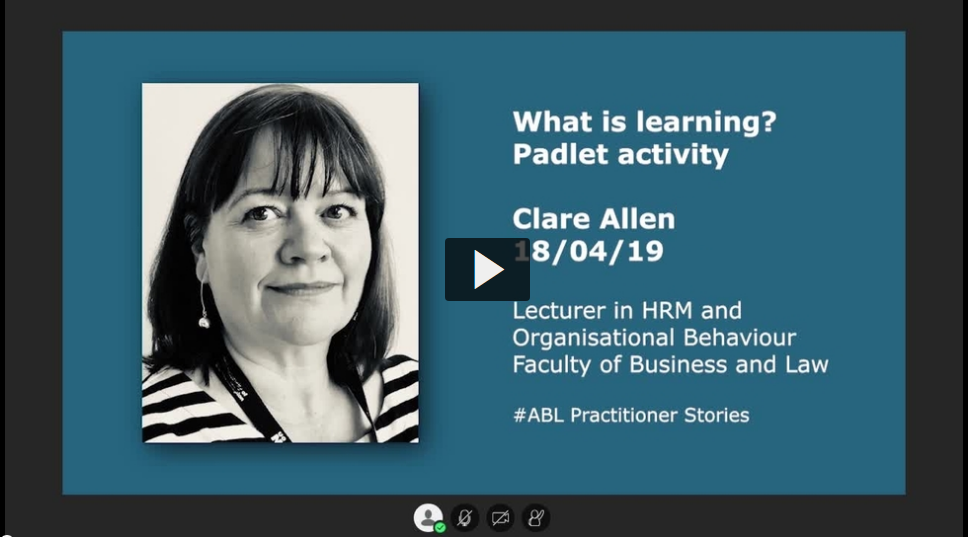
In this new ABL Practitioner Story, Clare Allen (Lecturer in Organisational Behaviour) shares her experience and thoughts on using Padlet in her teaching to support open group discussion.
At the beginning of the year, she asked the students to discuss in small groups what they thought learning was and to use Padlet to upload an image that best represented the thoughts of their group.
Clare talks about how she introduced this new tool to her students, why she found Padlet more engaging than simply delivering PowerPoints slides and what impact she feels it made on students understanding of their subject.
Listen to Clare in conversation with Richard Byles and Al Holloway, Learning Technologists for the Faculty of Business and Law, and if you’re interested in exploring how Padlet could support your teaching then copy the following link into your browser:
http://askus.northampton.ac.uk/Learntech/faq/186022
Padlet is available free to all staff and students at the University of Northampton and can be found on the NILE Help tab, under Tools & Resources.

GDPR – General Data Protection Regulation – Image from Pixabay (No attribution required)
The introduction of EU GDPR legislation in 2016 and it’s enforcement in May 2018 means that everyone who manages personal data is now responsible for ensuring that it is secure and that data is safeguarded using the highest privacy settings appropriate so that data is not publicly available without a lawfulness of processing criteria identified as required by GDPR Article 6. Although our VLE – NILE, is a secure network for students this law still applies and can guide us in how we best go about our day to day duties.
Device security.
When saving data it is best to either use the cloud storage ‘OneDrive’ or your network drives as locally saved data can be easily hacked should you lose your device. Article 9 of GDPR expects greater degrees of security for sensitive personal data (known as ‘special category data’) and so any personal information of this sort should also be password protected.
If you are unable to work online and are working on documents which contain student data such as Excel, then you should password protect these. – sensitive personal data should not be worked on offline and snapshots of University databases should never be used to process personal data offline.
When users login to NILE it is usually automated due to ‘single sign-on’ or your password may be held in the browser cache so anyone with access to your computer will be able to login to NILE to view student data. Therefore we strongly advise you do not allow any other users access to your machine, or leave it unattended. When not in use you should always lock the screen (Windows Key + L’ / Mac ‘Control + Shift + Power’).
If you lose either your work device or a mobile device which is linked to data such as your email, you should report this as a data breach to IT immediately via the UoN Service Desk. so they can secure your account, and the University Data Records Manager Phil Oakman, Phil.Oakman@northampton.ac.uk
Personal data breach.
If you become aware of a data breach you should inform the University Data Records Manager Phil Oakman, Phil.Oakman@northampton.ac.uk
Personal data breaches include:
- Access by an unauthorised third party,
- Deliberate or accidental action (or inaction) by a controller or processor,
- Sending personal data to an incorrect recipient,
- Alteration of personal data without permission,
- Loss of availability of personal data.
- Loss of personal data
- Personal data stolen
Secure passwords.
Basic passwords can be cracked very easily. This Tech.co article lists some good and bad examples of password
We suggest you don’t use your work password for any other sites, as this leaves our NILE and IT systems open to hacking, also don’t write your password down anywhere or send it on an email.
If you use your smartphone for work, then it is best to choose a longer passcode. A device called ‘GrayKey’ software is used by government agencies to access iPhones, and can crack a 4 digit security code in a few hours, and a 6 digit code in a few days, but an 8 digit code would take much longer to crack. It is highly likely that hackers use similar software to crack passwords on both IoS and Android, so it is best to increase the number of digits beyond 6.
If you suspect your password is not secure change it here: https://www.northampton.ac.uk/user
Sending data via Email.
Sending student data by emails is problematic for a couple of reasons; firstly data can be intercepted by email servers, and secondly, it is easy to send an email to the wrong person.
Do not include personal data and especially sensitive personal data in the body of an email.
To make these more secure you should password protect any files containing student data – such as grades exported from NILE, that you are sending, and send the password in a separate email within an attachment. (not titled ‘password’)
Releasing grades.
When revealing grades to students, only use the functionality within our VLE – NILE, as this ensures that this private data is only seen by the student to who it applies.
Staff should not use Announcements or Content areas to release grades or use group names or student numbers to anonymise them – as these are pseudo-anonymous and in breach of GDPR.
Group grades & feedback.
Any information posted into the ‘Feedback to Learner’ area in of a Blackboard Group assignment is released to all students in a group, therefore you should not include any grades in this area as this would be in breach of GDPR.
Identifying students by name.
Using student names to set up groups or perform tasks necessary for facilitating teaching and learning is a ‘Legitimate interest’ of data. However, staff should be aware that adding additional information such as student numbers, telephone number, address, or age, would be a potential security risk to the students NILE and University account.
Collecting data in collaborative activities.
Tools such as blogs, discussion boards and Padlets are often used for online collaborative activities (such as ice-breakers) in which students’ may be asked to share information about themselves. Data such as ethnicity, and sex is recorded in self-portraits and videos, or students may include information such as their home town, or sexual orientation in the written form.
Be particularly cautious of asking students to provide details which are commonly used for (banking) security questions such as; home town, name of pet, mother’s maiden name, favourite book and favourite holiday destination.
You may wish to consider whether the activity is a ‘legitimate interest’ of data as it is linked to the learning of the course, or whether you could redesign the activity to achieve the same learning outcomes without the need for students to provide personal data.
If it is necessary, you may wish to flag up to your students the issues of sharing personal data in a shared digital space. or ask their consent to be 100% GDPR compliant.
Video recordings and virtual classrooms.
In the virtual classroom platform Collaborate Ultra, students attending can share their webcams or microphones and post questions in the chat box, this becomes a GDPR issue when sessions are recorded, as all of these are held in recordings.
We recommend that staff either inform the students of the recording prior to the session – including details of where the recording will be made available and to whom. Or make the chat anonymous and remove the ability for students to share their camera and microphone in the session settings.
As it is possible to start and stop the recording during the session staff may choose to anonymise the chat and restrict access to the webcam and microphone during the recorded ‘instructional’ aspects of the session, then stop recording and make these available for when students are actively participating.
Use of Social Media Platforms.
The University’s policy on the use of social media in teaching and learning is that students should not be disadvantaged if they do not wish to sign up to these social media platforms.
The reason for this is that these providers are not licensed by the University and we can not expect our students to sign up to third-party terms and conditions. Therefore staff should only adopt social media tools to share content if all students can view the content without signing up for an account, examples of these are Twitter and Instagram.
For the same reason, staff should not ask students to use social media platforms (such as Facebook or WhatsApp) for class communications. There are already tools in the group settings within the VLE to do this such as discussion boards, blogs, email or Collaborate (groups)
If the use of Social Media is a learning outcome for a module, the course leader will need to make all potential students aware of this prior to enrolling on the course through a declaration on the course information page within the university website.
The use of social media is also relevant to GDPR, because social media platforms contain personal data which is not available in the VLE NILE and students are sharing data with third parties.
Third Party Tools
There are many very useful online tools such as Socrative, Kahoot and Prezi which are commonly used for teaching and learning but are not supported by Learning Technology. In a similar way to the University’s policy on social media accounts, the University policy says that students should not be disadvantaged if they do not wish to sign up to third-party tools. Therefore staff should either only use tools allow students to participate without setting up a new account, or provide a supported alternative option which does not prejudice the student.
This is relevant to GDPR because students are sharing data with third party providers.
Supported tools and licensed third-party publishers.
Tool and content providers within NILE have all provided GDPR policies to ensure they meet current legislation and confirm that our student data is secure. This includes a number of third-party content providers.
Please note, subjects which require students sign up to new accounts with third-party providers, should post a declaration on the course information page on the university website prior to enrolment to make students aware of this.
Sharing student data in research.
Before you start any research project you need to consider the implications of the data that you will be collecting, including how you will be obtaining this, how it will be stored, and how it will be preserved. A good data management plan will take you through these steps and will assist you in successfully obtaining research ethics approval. You can use https://dmponline.dcc.ac.uk/ using your university login details to create a data management plan. Further resources can be found on the research support yammer group.
Anonymisation or Pseudonymisation – GPDR
Two distinct techniques that permit data controllers and processors to use de-identified data. The difference between the two techniques rests on whether the data can be re-identified.
Recital 26 of the GDPR defines anonymised data as “data rendered anonymous in such a way that the data subject is not or no longer identifiable.” Emphasises that anonymised data must be stripped of any identifiable information, making it impossible to derive insights on a discreet individual, even by the party that is responsible for the anonymisation. When done properly, anonymisation places the processing and storage of personal data outside the scope of the GDPR.
GDPR defines pseudonymisation as “the processing of personal data in such a way that the data can no longer be attributed to a specific data subject without the use of additional information.”
By holding the de-identified data separately from the “additional information.” GDPR permits data handlers to use personal data more liberally without fear of infringing the rights of data subjects. This is because the data only becomes identifiable when both elements are held together.
By rendering data pseudonymous, researchers can benefit from new, relaxed standards under GDPR. For example, Article 6(4)(e) permits the processing of pseudonymised data for uses beyond the purpose for which the data was originally collected.
Recommended Software: ARX – http://arx.deidentifier.org/ (open source)
Post Contributors:
Richard Byles – Learning Technologist.
Phil Oakman – Data Records Manager.
Dawn Hibbert – Head of Research Support
Recent Posts
- H5P (HTML5 package) content types meets the needs of Jim Atkinson, Staff Development Trainer
- Blackboard Upgrade – July 2025
- StudySmart 2 – Student Posters
- NILE Ultra Course Award Winners 2025
- Blackboard Upgrade – June 2025
- Learning Technology / NILE Community Group
- Blackboard Upgrade – May 2025
- Blackboard Upgrade – April 2025
- NILE Ultra Course Awards 2025 – Nominations are open!
- Blackboard Upgrade – March 2025
Tags
ABL Practitioner Stories Academic Skills Accessibility Active Blended Learning (ABL) ADE AI Artificial Intelligence Assessment Design Assessment Tools Blackboard Blackboard Learn Blackboard Upgrade Blended Learning Blogs CAIeRO Collaborate Collaboration Distance Learning Feedback FHES Flipped Learning iNorthampton iPad Kaltura Learner Experience MALT Mobile Newsletter NILE NILE Ultra Outside the box Panopto Presentations Quality Reflection SHED Submitting and Grading Electronically (SaGE) Turnitin Ultra Ultra Upgrade Update Updates Video Waterside XerteArchives
Site Admin

